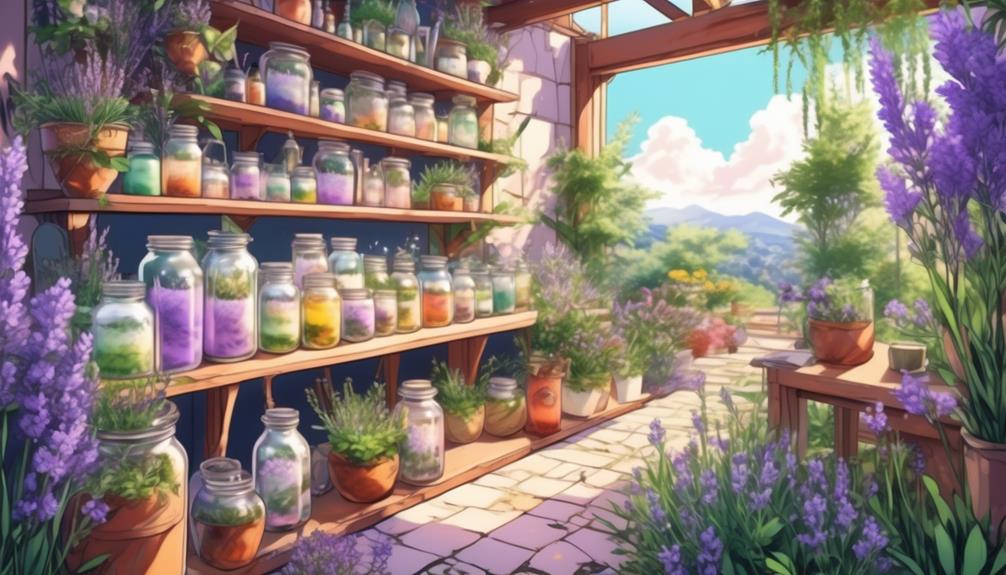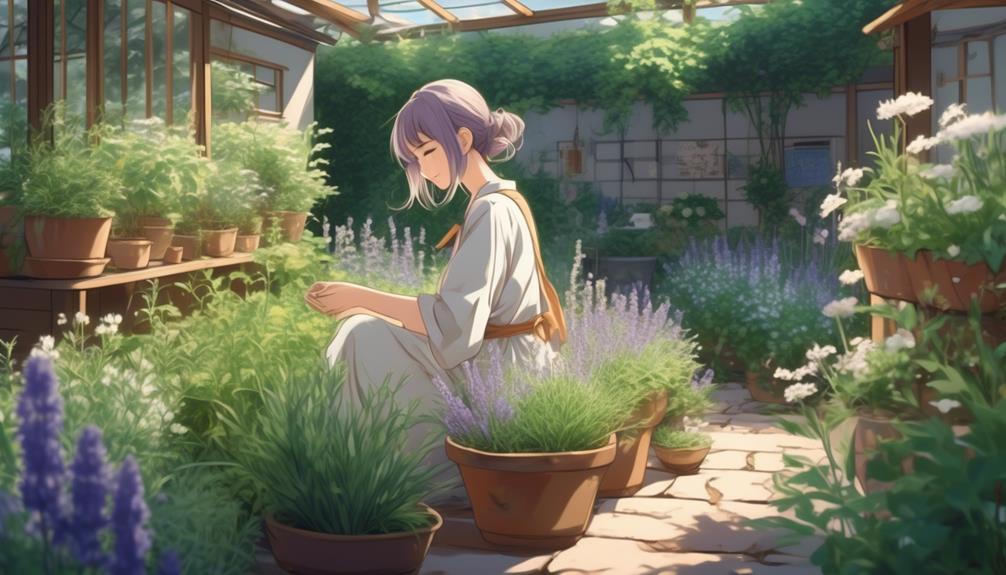They say beauty is only skin deep, but what if you could nurture that beauty from the very roots?
Imagine having a garden bursting with plants that not only enhance the beauty of your surroundings but also become the key ingredients for your own homemade beauty products. From lotions to masks, the possibilities are endless.
But why should you embark on this journey of cultivating your own beauty products? Well, here’s a little secret: it’s not just about the end result, it’s about the journey itself. The process of growing your own beauty ingredients allows you to connect with nature, take control of what goes on your skin, and embrace a more sustainable lifestyle.
So, let’s take a stroll through the garden and discover the wonders that await.
Beauty Plant Basics…
- Growing your own beauty plants allows you to customize beauty products with natural ingredients, reducing exposure to harmful chemicals.
- It gives you control over the ingredients and quality of your beauty products, allowing you to tailor them to meet your unique needs.
- Growing beauty plants can save you money and support sustainability, as you can use the plants directly instead of purchasing expensive beauty products.
- Essential herbs like chamomile, lavender, calendula, rosemary, and aloe vera have various benefits for DIY beauty products, including soothing skin irritations, promoting hair growth, treating scalp inflammations, and improving skin health.
Benefits of Growing Beauty Plants

Growing your own plants for homemade beauty products offers numerous benefits. It allows you to customize your beauty products with natural ingredients and reduce exposure to harmful chemicals commonly found in commercial alternatives. By growing your own herbs and garden plants, you have the power to create your own herbal cosmetics. This not only gives you control over what goes into your beauty products but also ensures that you’re using fresh, high-quality ingredients.
When you grow herbs and plants specifically for beauty purposes, you can tailor your products to meet your unique needs. You can choose plants that are known for their soothing properties, such as lavender or chamomile, or plants that are rich in antioxidants, like rosemary or green tea. By incorporating these natural ingredients into your beauty routine, you can improve the health and appearance of your skin and hair.
In addition to customization, growing beauty plants can also save you money in the long run. Rather than constantly purchasing expensive commercial beauty products, you can rely on your own garden to provide the ingredients you need. This not only reduces your expenses but also supports sustainability and eco-friendly practices by reducing your reliance on mass-produced products.
By growing your own beauty plants and making your own cosmetics, you also gain a sense of accomplishment and creativity. It’s a rewarding experience to see your plants thrive and then transform them into effective beauty products. This process allows you to connect with nature and take pride in the natural ingredients you use.
‘Did You Know? Cleopatra, the famous Egyptian queen, was known to use aloe vera from her own garden for her beauty routines. She’s a historic example of someone using home-grown beauty plants for skincare.’
Essential Herbs for DIY Beauty Products

To continue exploring the world of DIY beauty products, let’s now focus on the essential herbs that can be grown in your garden and incorporated into your own personalized skincare and haircare routines. By harnessing the power of natural plants and herbs, you can create effective beauty products that are free from harmful chemicals and additives.
Below are some key herbs that you can easily grow in your own garden and use in your homemade DIY beauty creations:
| Herb | Benefits | How to Use |
|---|---|---|
| Lavender | Calming, anti-inflammatory, skin-soothing | Infuse in oil for massage or bath, use in facial steam, make lavender water toner |
| Rosemary | Stimulates hair growth, antioxidant properties | Infuse in oil for hair treatments, add to homemade shampoo or conditioner |
| Chamomile | Soothes irritated skin, reduces inflammation | Make chamomile tea for facial steam, use in homemade face masks or toners |
| Calendula | Promotes healing, reduces redness | Infuse in oil for salves or creams, use in homemade lip balm or body lotion |
| Peppermint | Refreshing, cooling, relieves muscle tension | Infuse in oil for massage, add to homemade foot scrub or bath salts |
| Sage | Astringent, antimicrobial, reduces oiliness | Make sage tea for facial steam, use in homemade facial toner or acne treatments |
| Thyme | Antiseptic, anti-acne, promotes clear skin | Infuse in oil for face or body scrubs, add to homemade facial cleanser or toner |
| Mint | Refreshing, soothing, reduces inflammation | Use in homemade body butter or lip balm, add to foot soak or bath bombs |
| Aloe Vera | Soothes sunburns, hydrates, promotes healing | Use fresh gel directly on skin, add to homemade face masks or body lotions |
| Calendula | Promotes healing, reduces redness | Infuse in oil for salves or creams, use in homemade lip balm or body lotion |
Incorporating these herbal ingredients into your DIY beauty routine not only allows you to reap the natural benefits of these plants but also gives you a sense of belonging to the beauty community that values sustainability and natural remedies. So, why not start your own herbal beauty garden today and begin creating personalized beauty products that are truly unique and natural?
Herbs for Healthy Hair

Herbs have been used for centuries to promote healthy hair and address various hair concerns. They are rich in vitamins, minerals, and antioxidants that can nourish the scalp, strengthen hair follicles, and improve overall hair health.
Here are some popular herbs for healthy hair along with their benefits and a few homemade natural hair care recipes you can try:
Rosemary
Rosemary is known for promoting hair growth, preventing hair loss, and improving blood circulation to the scalp. It also has antimicrobial properties that can combat dandruff and dryness.
Recipe: Rosemary Hair Rinse
- Boil 2 cups of water and add 2 tablespoons of dried rosemary.
- Let it simmer for 15 minutes, then strain the liquid.
- Allow the mixture to cool and use it as a final rinse after shampooing and conditioning.
Lavender
Lavender not only has a calming aroma but also helps balance scalp oils, promote hair growth, and soothe an itchy scalp. It is also known to reduce stress, which can contribute to healthier hair.
Recipe: Lavender Infused Oil
- Fill a jar with dried lavender flowers and cover with a carrier oil like jojoba or almond oil.
- Seal the jar and keep it in a cool, dark place for 2-4 weeks.
- Strain the oil and use it as a scalp massage oil or as a leave-in treatment.
Aloe Vera
Aloe vera is a versatile herb that moisturizes the scalp, reduces dandruff, and strengthens hair follicles. It also helps balance the pH of the scalp and promotes healthy hair growth.
Recipe: Aloe Vera Hair Mask
- Mix 2 tablespoons of fresh aloe vera gel with 1 tablespoon of coconut oil.
- Apply the mixture to your scalp and hair, massaging gently.
- Leave it on for 30 minutes before rinsing with warm water.
Nettle
Nettle is rich in vitamins A and C, iron, and other minerals that promote hair growth, reduce hair shedding, and combat dandruff. It also helps improve circulation to the scalp.
Recipe: Nettle Tea Hair Rinse
- Pour 2 cups of boiling water over 2 tablespoons of dried nettle leaves.
- Let it steep for 30 minutes, then strain the liquid.
- Allow it to cool and use it as a final hair rinse after shampooing.
Hibiscus
Hibiscus flowers are packed with antioxidants that can strengthen hair, prevent hair fall, and add shine. It also helps balance pH levels and conditions the scalp.
Recipe: Hibiscus Hair Mask
- Blend a handful of hibiscus flowers with water to create a paste.
- Apply the paste to your hair and scalp and leave it on for 30 minutes.
- Rinse thoroughly with water and shampoo as usual.
Incorporating these herbs into your hair care routine can help improve the health and appearance of your hair naturally. Just remember to perform a patch test before using any new herb or ingredient to check for any adverse reactions.
Natural Remedies for Clear Skin

For clear and healthy skin, incorporating natural remedies into your beauty routine can be both effective and rewarding. When it comes to achieving clear skin, turning to nature’s gifts can provide you with the solution you need.
Aloe Vera
One plant that’s renowned for its skin benefits is Aloe Vera. This succulent plant not only calms and repairs the skin, but it also acts as a natural moisturizer. It can be used to treat burns, cuts, rashes, and wounds, making it a versatile addition to your beauty arsenal. The best part is, you can easily grow Aloe Vera in your own garden, ensuring a fresh supply of this wonder plant.
There are several ways you can use Aloe Vera for its skin benefits:
- Fresh Aloe Vera gel: Cut a mature leaf from the plant and slice it open. Scoop out the gel using a spoon and apply it directly to your skin. Massage it gently until it is fully absorbed. This can be done for moisturizing, soothing sunburns, or treating minor wounds.
- Aloe Vera face mask: Mix fresh Aloe Vera gel with a teaspoon of honey and a few drops of lemon juice. Apply the mixture to your face and leave it on for 15-20 minutes before rinsing off with warm water. This mask can help hydrate and brighten your skin.
- Aloe Vera toner: Blend fresh Aloe Vera gel with equal parts of rose water or witch hazel. Transfer the mixture to a spray bottle and spritz it on your face after cleansing. This can help balance the pH of your skin and tighten pores.
- Aloe Vera hair mask: Mix fresh Aloe Vera gel with a tablespoon of coconut oil and a few drops of your favorite essential oil. Apply the mixture to your scalp and hair, massaging it in gently. Leave it on for 30 minutes before shampooing as usual. This can help nourish and condition your hair.
Remember to do a patch test before using Aloe Vera on your skin, especially if you have sensitive skin. If any irritation occurs, discontinue use.
Calendula
Another plant that can work wonders for your skin is Calendula. Known for its soothing properties, Calendula can effectively treat skin inflammations, wounds, insect bites, and even eczema. Additionally, it can lighten dark hair, making it a versatile addition to your beauty routine. The flowers and leaves of Calendula can be used to create various beauty products, adding an aesthetic touch to your garden.
There are several ways to use Calendula for your skin:
- Calendula oil: Infuse dried Calendula flowers in a carrier oil like olive oil or coconut oil. Place the dried flowers in a clean, dry jar and cover them with the oil. Seal the jar tightly and leave it in a sunny spot for 2-4 weeks, shaking it occasionally. Afterward, strain the oil and transfer it to a dark glass bottle. You can use this oil as a moisturizer or massage oil for the skin.
- Calendula salve: Combine Calendula oil with beeswax to create a healing salve. Melt a small amount of beeswax in a double boiler, then add the Calendula oil. Stir until well combined and pour the mixture into a clean container. Let it cool and solidify, then use it as a salve for soothing wounds, insect bites, or dry skin.
- Calendula tea: Brew dried Calendula flowers in hot water to create a soothing tea. Allow the tea to cool, then use it as a facial toner or rinse for irritated skin. You can also soak a cloth in the cooled tea and use it as a compress for inflamed areas.
- Calendula bath: Add a handful of dried Calendula flowers to a warm bath to enjoy their soothing properties. Soak in the bath for at least 15 minutes to allow the Calendula to work its magic on your skin.
Remember to perform a patch test before using any Calendula product to ensure you do not have an allergic reaction. If you experience any irritation or discomfort, discontinue use immediately.
Lavender
Lavender is another botanical gem that can help you achieve clear skin. With its natural anti-inflammatory and antiseptic properties, Lavender cleanses and soothes the skin. It’s effective in treating acne, cuts, burns, stretch marks, and wrinkles. Not only that, but Lavender can also enhance the fragrance of your beauty garden, making it a delightful addition to your space.
There are several ways you can use lavender to benefit your skin:
- Lavender Oil: Dilute a few drops of lavender essential oil with a carrier oil, such as coconut or jojoba oil. Apply the mixture to your skin using a cotton ball or your fingertips. Gently massage it into your skin in circular motions. Leave it on for about 10-15 minutes, then rinse off with warm water. This can help reduce inflammation, soothe irritation, and improve the overall appearance of your skin.
- Lavender Steam: Fill a bowl with hot water and add a few drops of lavender essential oil. Place your face over the bowl and drape a towel over your head to create a steam tent. Allow the steam to open up your pores and let the lavender’s antiseptic properties cleanse your skin. This can be particularly beneficial for acne-prone skin.
- Lavender Face Mask: Mix 2 tablespoons of dried lavender flowers with 1 tablespoon of honey and 1 tablespoon of yogurt. Apply the mixture to your face and leave it on for about 15-20 minutes. Rinse off with warm water. This mask can help hydrate, soothe, and brighten your skin.
- Lavender Toner: Brew a strong cup of lavender tea and let it cool down. Transfer the tea into a spray bottle and use it as a facial toner after cleansing your skin. Lavender toner can help balance your skin’s pH levels, tighten pores, and refresh your complexion.
Remember to do a patch test before using any new product or ingredient on your skin, especially if you have sensitive skin or allergies.
Rosemary
Rosemary is a herb that not only adds flavor to your culinary creations but also offers numerous benefits for your skin. With its natural anti-inflammatory, antiseptic, and astringent properties, Rosemary can soothe irritated skin and improve circulation. It stimulates skin cell and hair growth, making it an excellent choice for those looking to promote clear skin. Additionally, Rosemary can be used as a natural hair dye to darken hair, adding versatility to your beauty routine.
There are several ways to incorporate rosemary into your skincare routine:
- Rosemary-infused oil: Infuse rosemary leaves in a carrier oil such as olive oil or jojoba oil. Place the rosemary leaves in a jar and cover them with the oil. Let it sit for a few weeks, shaking the jar occasionally. Strain the oil and use it as a moisturizer or massage oil for your skin.
- Facial steam: Boil a pot of water and add a handful of fresh or dried rosemary leaves. Remove from heat and place a towel over your head to create a steam tent. Lean over the pot and let the steam gently cleanse and open your pores. This can help improve circulation and give your skin a healthy glow.
- Rosemary toner: Brew a strong cup of rosemary tea by steeping fresh or dried rosemary leaves in hot water. Let it cool, then strain the liquid into a bottle. Use a cotton pad to apply the rosemary toner to your face after cleansing. It can help tighten pores and balance the skin’s pH.
- Rosemary hair rinse: Brew a strong cup of rosemary tea and let it cool. After shampooing your hair, pour the rosemary tea over your hair as a final rinse. This can help stimulate hair growth, darken hair color, and add shine.
Remember to do a patch test before using rosemary directly on your skin to check for any allergic reactions.
DIY Facial Masks for Glowing Skin

Create your own DIY facial masks using the power of garden plants to achieve a radiant and glowing complexion. By utilizing beauty products from natural sources, you can enhance your skincare routine with plant-based ingredients that are both effective and sustainable.
During the growing season, you can cultivate herbs such as chamomile, lavender, and calendula in your garden, providing you with fresh and potent ingredients for your homemade facial masks.
To create a moisturizing and rejuvenating mask, mix a tablespoon of honey with aloe vera gel and a few drops of your favorite essential oil. Honey helps to hydrate the skin while aloe vera soothes and nourishes. Essential oils like lavender or chamomile provide additional benefits, such as calming and reducing inflammation.
For a cleansing and tightening mask, combine ground oatmeal with chamomile tea and a few drops of lavender oil. Oatmeal acts as a gentle exfoliant, removing dead skin cells and impurities. Chamomile and lavender have astringent properties that help to tighten pores and leave your skin feeling refreshed.
Herbal Astringents for Toning Skin

When making your own homemade beauty products using garden plants, it’s essential to understand the benefits of herbal astringents for toning your skin. Herbal astringents help restore the skin’s natural acidity and tighten pores, leaving you with a refreshed and rejuvenated complexion. These natural toners are made from garden plants and are a wonderful addition to your skincare routine.
Here are some popular herbal astringents and their benefits for toning and cleansing the skin:
| Herbal Astringent | Benefits |
|---|---|
| Lavender | Known for its pore-tightening and skin-cleansing properties. Leaves your skin feeling refreshed and balanced. |
| Chamomile | Soothes and calms the skin, while tightening and toning. Ideal for sensitive and acne-prone skin. |
| Witch Hazel | Reduces inflammation, tightens pores, and helps control excess oil production. Suitable for all skin types. |
| Rosewater | Hydrates and refreshes the skin, leaving it toned and revitalized. Great for dry and mature skin. |
Incorporating herbal astringents into your skincare routine can help restore your skin’s natural balance while providing a gentle toning effect. To make your own herbal astringent, you can infuse these garden plants in distilled water or use them as an ingredient in DIY facial masks. Take advantage of the natural goodness of garden plants to achieve healthy, toned skin.
“Did You Know? The term ‘astringent’ comes from the Latin word ‘adstringere’ which means ‘to bind fast’. This is because astringents work by shrinking or contracting body tissues, hence their popular use in skincare for tightening pores and toning the skin.”
Creating a Herbal Hair Care Routine

To establish a holistic approach to hair care, consider incorporating a herbal regimen that harnesses the power of nature’s botanical wonders. Creating a herbal hair care routine can’t only enhance the health and appearance of your hair but also provide a sense of connection to the natural world.
Start by choosing herbal shampoos that are tailored to your hair color, such as using calendula for red hair, lavender for brunettes, and chamomile for blondes. These herbs can help enhance your hair’s natural shine and vibrancy. Additionally, you can explore herbal rinses using calendula, lavender, chamomile blossoms, or sage leaves to stimulate the scalp and encourage hair growth. These rinses can be brewed as herbal tea and applied after shampooing to invigorate your hair and scalp.
For an extra boost of nourishment and hydration, consider experimenting with homemade hair masks using natural ingredients like coconut oil, aloe vera, and essential oils. These masks can deeply moisturize your hair, leaving it soft and manageable. Furthermore, you can create your own DIY hair oils made from herbs like rosemary, which is known for promoting hair growth and reducing frizz. Simply infuse the herbs in a carrier oil of your choice and apply it to your hair and scalp.
Lastly, if you’re dealing with dandruff or scalp issues, herbal remedies can also come to your rescue. Herbal hair rinses or masks containing ingredients like tea tree oil, neem, or peppermint can help soothe the scalp and alleviate these concerns. By creating a herbal hair care routine, you can tap into the healing power of plants and nurture your hair in a natural and sustainable way.
Its In Your Garden…
So there you have it, the secret to beautiful skin lies right in your garden.
By growing your own beauty plants, you can create personalized skincare products that are natural, chemical-free, and tailored to your specific needs. It’s ironic that in this age of expensive beauty products, the most effective solutions can be found in our own backyard.
So why not embrace the power of nature and start growing your own beauty ingredients today?
Your skin will thank you.

